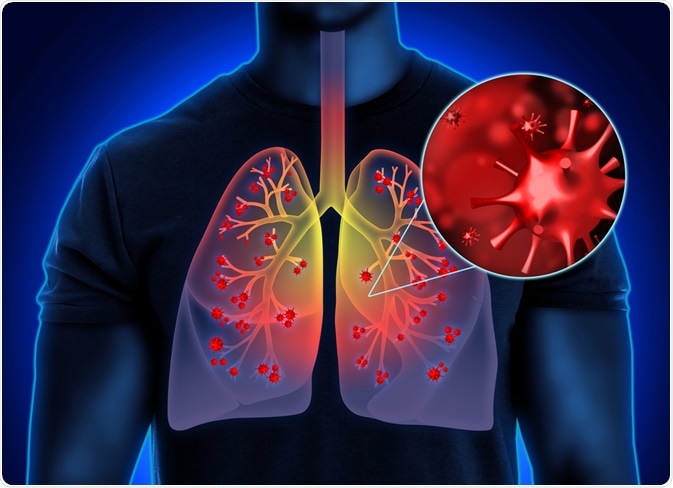Nitric oxide (NO) has been used for decades in cases of acute respiratory distress syndrome (ARDS) as a vasodilator, improving gas exchange in the lungs and allowing the blood to better oxygenate.
NO is naturally produced by many cells of the body and plays an important role in signaling and homeostasis. It functions as a vasodilator by bonding with and activating the enzyme guanylate cyclase in the cytoplasm of vascular smooth muscle cells, leading to the production of cyclic-guanosine 3',5'-monophosphate.
This molecule is capable of activating protein kinase G (PKG), which is ultimately responsible for most of the vasodilatory and platelet inhibition effects of NO. PKG activates myosin phosphatase, leading to the release of calcium ion stores from the smooth muscle cells, relaxing them.
 COVID-19 can cause acute respiratory distress syndrome (ARDS) in severe cases. Image Credit: New Africa / Shutterstock.com
COVID-19 can cause acute respiratory distress syndrome (ARDS) in severe cases. Image Credit: New Africa / Shutterstock.com
How can the effects of nitric oxide be assessed?
The PaO2/FiO2 ratio is the ratio of arterial oxygen partial pressure to fractional inspired oxygen, given in units of pressure (mmHg or kPa). For example, a typical PaO2 for a healthy person at sea level may be 100 mmHg with a FiO2 of 0.21 (21%), making the PaO2/FiO2 ratio 476.2 mmHg.
A healthy ratio is considered one over 400 mmHg, and so a patient with a ratio below this may receive extra oxygen in the form of a nasal cannula or mask. A nasal cannula provides around 4% FiO2 per liter of oxygen provided per minute (Lmin-1), so a patient receiving 5 Lmin-1 would have an FiO2 of 0.4 (40%) in a room with 20% oxygen.
Nitric oxide improves the PaO2/FiO2 ratio by enhancing oxygen transfer in the lungs through vasodilation. As a gaseous molecule, it is lipophilic, and so readily diffuses across the pulmonary membranes causing localized vasodilation. NO is deactivated upon reacting with hemoglobin and oxygen in the blood, meaning that its effects only spread minimally to other parts of the body when inhaled.
A recent study by Garfield et al. (2020) looked at 35 cases of patients being treated with 20 ppm NO for an average of 146 hours while suffering from serious COVID-19 related ARDS. Within 24 hours most patients had a significant increase in the PaO2/FiO2 ratio, which was maintained in those patients that survived up to 5 days. A very small number of other studies had previously reported largely neutral results from NO administration, but the authors of this paper note particular biomarkers that indicate a good outcome.
Brain natriuretic peptide (BNP) is a hormone released in response to stretching caused by increased ventricular blood volume, lowering the blood pressure. Troponin is found in skeletal and cardiac muscle, blocking the attachment site for the myosin cross-bridge and preventing contraction of the muscle. The presence of high concentrations of these biomolecules indicates severe hypoxaemia, likely due to right ventricle strain often associated with covid-related pneumonia, and these patients were found to benefit most greatly from treatment with NO.
Should NO be applied to COVID-19 patients?
Other recent studies support the use of inhaled NO application to ARDS patients with COVID-19, improving arterial oxygenation without increasing the concentration of carbon dioxide. Other factors beyond the direct vasodilating and platelet-inhibiting effects of NO have been suggested to come into play, including alterations in immune response, antiviral properties, effects on surfactant, and the regulation of angiotensin receptors.
In addition to the route discussed above, inhaled NO also regulates pulmonary vasodilation by activation of potassium channels and angiotensin receptors, and may play a role in protecting the lungs from oxidative damage. However, NO has been noted to act as an irritant to the lungs, causing inflammation. Interestingly, this could potentially be a positive situation as the lungs are then primed to produce macrophages due to the inflammation caused, though most severe COVID-19 cases are in fact induced by an overly active immune response, potentially then exacerbating this effect.
Pulmonary surfactant is a surface-active lipoprotein complex formed in alveolar cells that bears both hydrophobic and hydrophilic regions, allowing gas to diffuse through it. The surface tension of the surfactant ensures that the alveoli fill evenly, forcing their inflation rate to slow as they expand. NO decreases the surface tension of the surfactant, allowing poorly expanding alveoli to better inflate against the weakened surface tension of the surfactant. This can allow damaged lungs to function slightly more effectively.
In conclusion, NO may be effectively applied to COVID-19 patients suffering with ARDS to improve blood oxygenation and prolong life, though has no bearing on the progression of illness.
Inhaled Nitric Oxide (iNO): Evidence-Based Health Information Related to COVID-19
References
- Tousoulis, D. et al. (2012) The role of nitric oxide on endothelial function. Current Vascular Pharmacology, 10(1). https://pubmed.ncbi.nlm.nih.gov/22112350/#:~:text=Abstract,nitric%20oxide%20synthase%20(NOS).
- Ricou, B., Grandin, S., Jolliet, P., Chevrolet, J. C. & Suter, P. M. (1994) Nitrous oxide (NO) in the treatment of adult respiratory distress syndrome. Swiss Medical Weekly, 124(14). https://pubmed.ncbi.nlm.nih.gov/8184298/
- Gaston, B. (2005) Summary: Systemic Effects of Inhaled Nitric Oxide. Proceedings of the American Thoracic Society, 3(2). https://www.atsjournals.org/doi/full/10.1513/pats.200506-049BG#:~:text=Inhaled%20NO%20can%20affect%20blood,effects%20of%20NO%20synthase%20inhibition.
- Garfield, B. et al. (2020) Potential for personalised application of inhaled nitric oxide in COVID-19 pneumonia. British Journal of Anaesthesia, 126(2). https://bjanaesthesia.org/article/S0007-0912(20)30918-1/fulltext
- Lotz, C. et al. (2020) Effects of inhaled nitric oxide in COVID‐19–induced ARDS – Is it worthwhile? Anaesthesiologica Scandinavica, 1. https://onlinelibrary.wiley.com/doi/epdf/10.1111/aas.13757
- Weinberger, B., Heck, D. E., Laskin, D. L. & Laskin, J. D. (1999) Nitric oxide in the lung: therapeutic and cellular mechanisms of action. Pharmacology & Therapeutics, 84(3). https://www.sciencedirect.com/science/article/pii/S0163725899000443?via=ihub
Further Reading
Last Updated: Feb 16, 2021